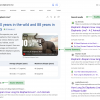Tableau is a versatile business intelligence and analytics tool that is widely used across industries for reporting and decision-making. It has a reputation for transforming complex data into actionable insights and is favored by professionals who want to leverage data effectively. While Tableau offers a suite of tools to meet a variety of analytical needs, it may not be the ideal choice for individuals or startups with smaller analytics requirements.
Tableau is used for reporting, data analysis, and decision-making processes in organizations across departments. It can track key performance indicators, conduct market research, and forecast trends. With its intuitive interface and powerful visualization capabilities, Tableau allows users to connect to various data sources and transform data into interactive dashboards and reports. These visualizations help users identify trends and insights that may not be evident in raw data.
To use Tableau, users need to connect to their data source, which can include Excel, cloud-based data, and SQL databases. They can then create visualizations using a drag-and-drop interface, choosing from a variety of chart types, applying filters, and exploring data in-depth. Tableau also enables the creation of dashboards that combine multiple visualizations, facilitating collaborative decision-making by allowing insights to be shared on Tableau Server or Tableau Online.
The ease of learning Tableau depends on an individual’s background and experience with data analysis tools. While beginners can start creating basic visualizations relatively easily, mastering advanced features such as complex calculations and data modeling may require additional time and practice. Tableau provides a wealth of learning resources, including tutorials, forums, and training sessions, to support the learning process.
While prior knowledge of Excel or SQL is not necessary to use Tableau, familiarity with these tools can enhance the user experience. Excel skills help with data organization and basic analysis, while SQL knowledge is beneficial for working with large databases or performing complex queries within Tableau. However, Tableau is designed to be accessible to non-technical users, providing ways to manipulate and analyze data without advanced skills in Excel or SQL.
Tableau’s key features include data visualization, a drag-and-drop interface, advanced analytics, data blending capabilities, and real-time data processing. These features make it a top choice for teams with varying levels of data experience. Tableau excels in transforming raw data into meaningful visualizations, making it excellent for data-driven decision-making and creating comprehensive reports and dashboards. However, it may not be suitable for detailed statistical analysis or advanced predictive modeling, and very small businesses or individual users with limited data analysis needs might not fully utilize its features.
Tableau integrates with a wide variety of cloud services, customer relationship management systems, big data tools, business applications, spreadsheet tools, and dashboard applications. Some of its dashboard application integrations include WriteBackExtreme, Write-Back Form Builder, Pixel Perfect by USEReady, Synchronized Refresh by phData, and Kinetica Geospatial Analytics by Kinetica.
Tableau has established itself as a significant player in the business intelligence and analytics software market, with a market share of 15.09% in the business intelligence category. Its acquisition by Salesforce in 2019 for $15.7 billion further solidified its position in the market. Tableau’s reputation as a top BI and analytics tool is evidenced by its consistent ranking as a leader in Gartner’s Magic Quadrant industry analysis since 2012.
Tableau’s main competitors include Google Looker, Alteryx, Domo, and Databox, each offering their unique features and capabilities in the BI and analytics space.






